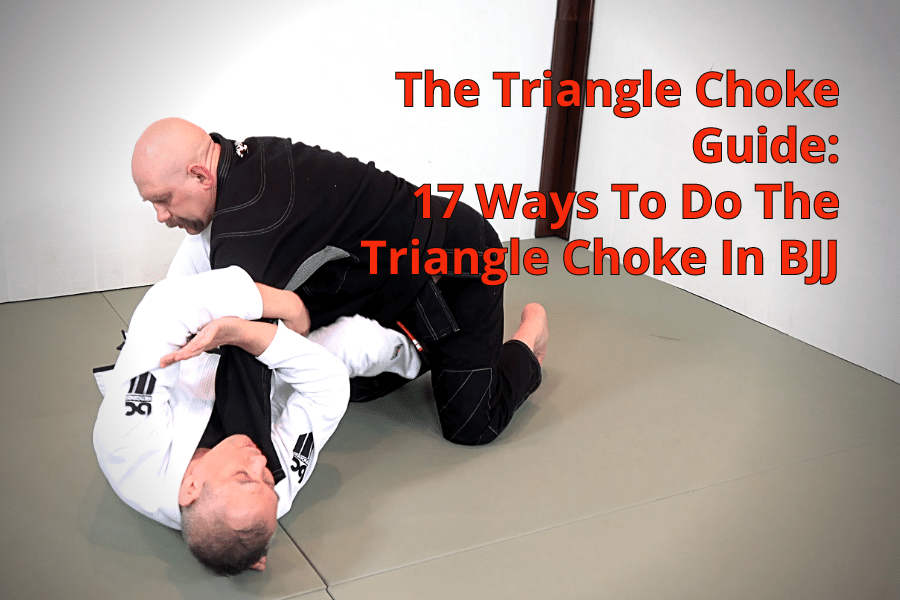
The triangle choke is one of the most powerful and versatile submissions in BJJ. Here’s 17 ways to set up and execute the triangle choke.
It’s my hope that from seeing the different ways to do the triangle choke, you’ll eventually develop a deeper, more thorough understanding of what the triangle choke is and how to do it!
Let’s get started!!
First, let’s talk about how to to finish the triangle choke.
Now, how do we get into this position?
Here’s 17 of my favourite ways to hit the triangle choke!
Closed Guard Triangle Choke. The Inside Entry.
The triangle choke is one of the principle attacks from the guard. Starting in closed guard, you always want to break your partner’s posture down. Once their hand is on the floor, you want to control their arm with an overhook. Now look to get your knee on to the inside of their bicep, control their wrist; and then, throw your leg over to get the triangle position.
Closed Guard Triangle Choke. The Outside Entry.
Getting the triangle with your leg circling the outside of your partner’s arm is started from overhooking your partner’s arm. Next, control your partner’s free hand by grabbing all 4 fingers; and then, pull their hand underneath your guard; so, you can get the triangle position.
Closed Guard Omoplata To Triangle Choke.
Although the omoplata is one of the most powerful submissions from the guard; like all attacks, nothing works all the time; and thus, we need to look at transitioning to other techniques. When your partner starts to posture to defend the omoplata, pummel your leg over their far shoulder to get the triangle.
Closed Guard Kimura To Triangle Choke.
Personally, the kimura is my absolute favourite attack; but, it’s not only a submission, it’s a gateway to other techniques. As your partner looks to defend your kimura, throw your leg over their far shoulder to get into the triangle position.
Spider Guard Foot On Bicep Triangle Choke.
With a collar/sleeve grip on your partner, use your foot to check your partner’s bicep, when your partner fails to control your pant leg, you can now shoot your leg over their shoulder to get the triangle.
Spider Guard Double Sleeve Triangle Choke.
The double sleeve spider guard grip is one of the most powerful controls you can get on your partner. Initiate your attack by first trying to sweep your partner with your foot on their bicep. As they defend the sweep, kick your leg over their shoulder to enter into the triangle choke.
Shallow Leg Lasso To Triangle Choke.
Leg Lasso is one of the best ways to control a fast moving, athletic partner from your spider guard. But, unfortunately, as strong as the leg lasso control is, it can be tough to move directly into a submission. What I recommend is a shallow leg lasso; meaning, just having your heel on your partner’s elbow; thus, enabling both a strong control of your partner; along with, a quick opening to a triangle choke when the moment arrises.
2 On 1 Butterfly Guard Sweep Into Triangle Choke.
Sometimes, your butterfly guard sweep doesn’t lead directly into a sweep; but instead, creates an opening for additional attacks. As you attempt your butterfly guard sweep; mostly likely, your partner will post their hand on the ground to defend the sweep; however, this opens your partner up for an immediate triangle choke.
Butterfly Guard Pressing Armbar To Triangle Choke.
Your butterfly guard is a very versatile guard that can lead to many separate sweeps and submissions; plus, attacking in a series of techniques is one of the best ways to finish your partner. Look to initiate the sequence with a sweep, and as your partner defends the sweep by posting their arm out, you’re going to transition into a pressing armbar; and then, as the pressing armbar fails, you’re going to switch to a triangle choke as the final finishing technique.
Half Guard Pressing Armbar To Triangle Choke.
Almost always when you’re fighting from half guard, your partner will be trying to control you with a cross face. As your partner reaches with their arm for a cross face, this is your opportunity to attack with a pressing armbar. However, when your pressing armbar fails because your partner is posturing up; then, this is the perfect opportunity to switch to a triangle choke.
Half Guard Overhook Armbar To Triangle Choke.
Fighting from half guard is the fight for the underhook; however, when your partner wins the underhook, you can counter with an overhook armbar. In most cases, your partner will defend your overhook armbar by posturing up; thus, allowing you to follow up with a triangle choke.
Over/Under Guard Pass To Triangle Choke.
The over/under guard pass is one of the most dominate ways to get around the guard; however, this guard pass can be countered with a well timed triangle choke.
Cross Side Triangle Choke.
This is a sneaky triangle choke you can do from cross side once you have controlled your partner’s near arm. Bring your leg over your partner’s shoulder and as your partner attempts to sit up, they’ll fall perfectly into your triangle choke.
Mount Triangle Choke.
When you’re able to bring your leg over your partner’s shoulder when you’re in mount; then, you can go for one of the most powerful triangle variations. The key is to not only be perpendicular to your partner; but, as well, you want to only have one knee on the ground so your triangle choke can be as tight as possible.
Back Triangle Choke.
Trapping your partner’s hands when you have their back is the proper procedure when going for a rear naked choke; however, as your partner tries to escape by sliding down towards your legs, they are now perfectly susceptible to a back triangle choke.
Knee On Belly 180 Armbar To Triangle Choke.
If you go for a 180 armbar; typically, one of your partner’s arms will be in between your legs. If this happens, a quick and easy transition is to fall to the side for a triangle choke.
Failed Armbar To Triangle Choke.
Your partner will almost always connect their hands to defend your armbar. While there’s many ways to disconnect their hands, an easier solution is to sometimes kick your leg through for a triangle choke.



